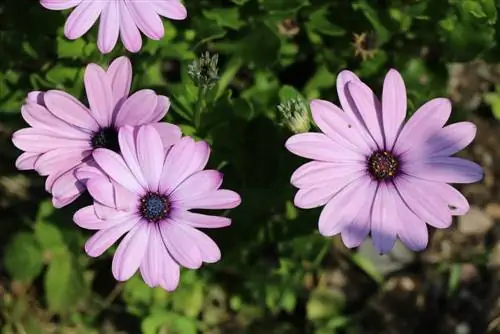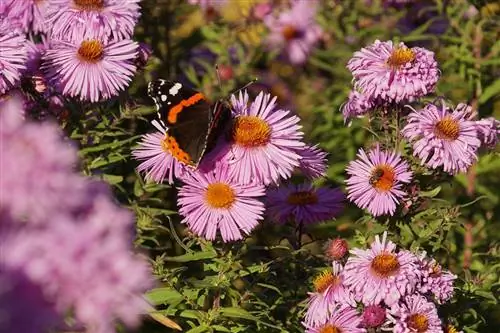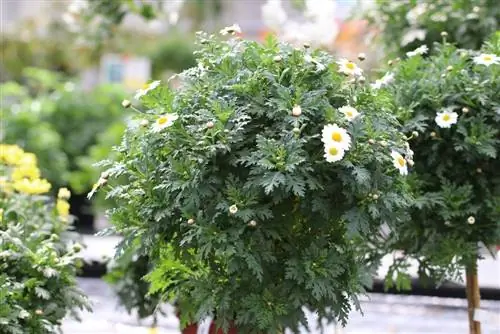- Author admin [email protected].
- Public 2023-12-17 03:39.
- Last modified 2025-01-24 12:45.
From sun-drenched South Africa, an evergreen subshrub with colorful flower discs found its way into our summer gardens. The large basket flowers stretch tirelessly towards the sun in abundance. Only the cool temperatures in late autumn put an end to the flower show. Until then, the Bornholm daisy needs to be lovingly cared for so that it doesn't run out of floral steam during the long flowering period. Read here what care is important for the subtropical flower beauty. This is how you can successfully overwinter your charming Cape basket.
Care
Although the Bornholm daisy requires regular attention, the demands can easily be met even by the novice gardener. The following explanations on location, watering, fertilizing, cutting and overwintering provide proof that exotic flowering plants can be easily integrated into the design plan as pot or bed plants.
Location
The blooming Bornholm daisy comes from the warmth-loving and sun-drenched family of Cape daisies. Accordingly, the perky summer flower wants a location with these basic conditions:
- Full sun to partial sun and warm
- Preferably in wind-calmed locations so that the flower stems don't bend
- In the partially shaded location, the abundance of flowers falls short of expectations
The Cape daisy prefers to display its flowers on the summer balcony and the sunny terrace. The flower-rich subshrub likes to join the summer flowers in the perennial bed in order to compete with their floral beauty. A place in the garden bed is of course associated with the disadvantage that only one-year cultivation is possible due to the lack of winter hardiness.
Tip:
Use your Bornholm daisy as a floral weather prophet. When it rains, the distinctive flowers close or don't open at all.
Substrate and soil conditions
As a potting substrate, the Osteospermum ecklonis wants a well-drained, humus-rich potting soil with a low peat content. Add some more sand, perlite or lava granules to prevent compactions from forming that lead to waterlogging. The flowering bush has no special demands on the soil in the bed. The Bornholm daisy likes to extend its roots in any good garden soil. The pH value can range from slightly acidic to neutral to alkaline.
Pouring
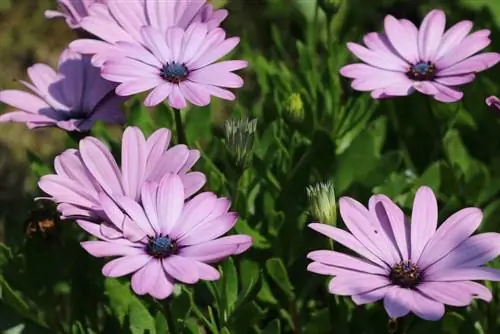
The Bornholm daisy loses a lot of moisture on warm summer days through its lush flowers and leaves. Although the South African immigrant knows how to cope with short-term drought, this situation should be the exception. How to water the plant correctly:
- If the substrate dries on the surface, water it with normal water
- Let the water run out of the spout in the pot or balcony box until it flows out of the bottom opening
- Stop watering in the bed if small puddles form
Please do not water the plant in direct sunlight. Then every single drop on the leaves and flowers turns into a mini burning glass to inflict burns on the tissue cells.
Fertilize
The Bornholm daisy invests a lot of energy in its magical flowers. Since even nutrient-rich soil cannot compensate for consumption, the tropical subshrub is dependent on fertilizer. In container cultivation, a commercially available liquid fertilizer fulfills this task. In an ecologically managed garden, you can use organic fertilizer for bedding plants, such as compost, horn shavings, guano granules or horse manure. If multi-year cultivation is planned, stop supplying nutrients in August so that the plant matures before winter.
Cutting
Some South African Cape basket hybrids tend to take a break from flowering in the middle of the season. In order to revitalize the tired daisies, they receive a repair cut. To do this, cut back any wilted flower stems to the nearest pair of he althy leaves. If the weather cooperates, this measure will trigger the next wave of flowers. Alternatively, brush out each flower individually as it fades to induce continuous rebloom.
Before putting away, cut each cape daisy back to a third of its height. Of course, this does not apply to bedding plants that end their guest appearance in the garden in late autumn. Pull these out of the ground before the first frost and dispose of the remains in the compost.
Tip:
With its cheerful, colorful flowers, the Bornholm daisy in the vase radiates its floral charm into the house. Cut the prettiest stems when the flowers have just opened. Before putting them in the fresh, not too cold water, the stem ends are cut 2-3 cm.
Wintering
When Father Frost knocks on the garden gate, the lush floral splendor is over. Although a Bornholm daisy can survive temperatures around freezing point for a short time, it is not frost-resistant enough for a Central European winter outdoors. Therefore, one-year cultivation is the rule in our latitudes. Where there is enough space, there are good prospects of overwintering for Cape daisies in pots and balcony boxes. This is how it works:
- Put away the plant containers when temperatures fall below 5 degrees Celsius
- Cut back to a third of the height
- Set up in bright winter quarters with temperatures of at least 5 to a maximum of 15 degrees Celsius
- Water sparingly and do not fertilize
If a Cape basket in the bed has developed into a voluminous flower bush over the course of the summer, you can try the experiment of overwintering. To do this, dig up the plant after pruning so that as much root volume as possible is retained. Place the daisy bush in a pot with loose potting soil and place it in a frost-free, light-flooded room.
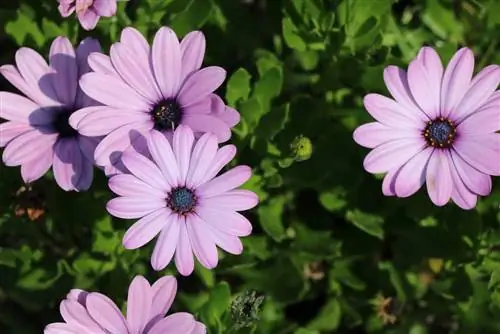
From the beginning/mid of April, gradually accustom the overwintered Bornholm daisy to the sun by placing the pots in a partially shaded, later sunny location on the balcony during the day. The sprouting plants spend the cool nights behind glass until mid-May. In proportion to growth, increase the amount of irrigation water and apply the first fertilizer.
Tip:
Where temperatures do not fall below -5 degrees Celsius in mild winter regions, there is the option of overwintering outdoors. Well protected under a 30 cm high layer of leaves, secured with coniferous twigs, the plan can succeed.
Repotting
Successful overwintering results in a change to a larger pot with fresh substrate in early spring. Your Bornholm daisy will respond to this revitalization treatment with vigorous budding and numerous strong buds. The new plant container should be 3-5 cm larger in diameter and have one or more openings in the bottom for water drainage. A few pieces of pottery, pebbles or expanded clay balls act as drainage, covered with a breathable fleece to protect against siltation. First fill in a layer of fresh potting soil. Then pot up the plant and shake off the old soil thoroughly. If you notice dead root strands, please cut them off with sharp, clean scissors. After this preparatory work, it continues like this:
- Make a small depression in the already filled substrate with your fist
- Place the root ball in the middle
- Stabilize the plant with one hand and fill in the fresh soil with the other hand
Maintain the previous planting depth, press the substrate and water thoroughly. In a partially shaded, warm location, the repotted Bornholm daisy regenerates for 8 to 10 days before it returns to its original place.
Propagate
Cuttings
In order to establish more Bornholm daisies in the garden, a vital mother plant provides you with excellent propagation material in early summer. At this time, life is pulsating right up to the shoot tips, so now is the best time to cut head cuttings. To do this, cut off half-woody, non-flowering branches that are 10 to 15 cm long. Position the scissors so that the cut is made just below a leaf node or a sleeping eye. Then remove all leaves except for the top pair of leaves. Place two-thirds of the cuttings in pots that are filled with a mix of sand and peat or commercial potting soil. Follow these steps:
- Moisten the substrate well without causing waterlogging
- Put a transparent bag over each pot
- Water and ventilate regularly in a partially shaded, warm location
Insert small wooden sticks into the substrate to act as spacers to prevent the bag from coming into contact with the cutting. If fresh leaves sprout, the cover can be removed. Within a short time, the offshoots have rooted through the pot and can be repotted or planted out.
Sowing
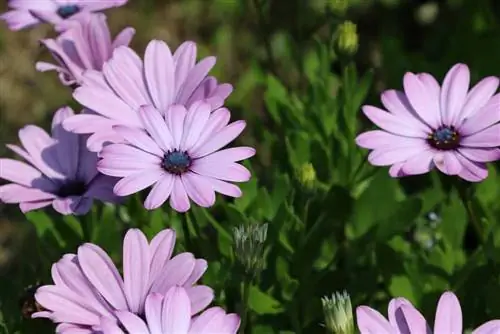
To harvest the seeds of a Bornholm daisy yourself, do not cut off all the withered flowers in summer. The seeds ripen in the middle of the ray flowers by autumn. Only when they have turned brown do you cut off the seed heads. The seeds can be selected by rubbing them between your fingers and shaking them repeatedly through a sieve. Keep the seeds dry, cool and dark until February. Now the time window for sowing on the windowsill opens. This is how it works:
- Fill a seed tray with peat sand or seed soil
- Sprinkle the seeds on top, sieve thinly, press down and water with a fine spray
- Water regularly in the heated mini greenhouse in a partially shaded location at 25 degrees Celsius
- After germination, lower the temperature to 20 degrees Celsius
Seedlings with more than 2 pairs of leaves are transplanted into individual pots and cared for in a warm, bright window seat. By the beginning of the season, the seedlings have transformed into strong young plants.
Beautiful varieties
The diverse varieties of Bornholm daisy surprise with bright colors in unexpected nuances. The following selection presents you with outstanding hybrids for beds and balconies:
Lemon Ice
The premium variety from the 3D series impresses with its double flowers. In the middle of the flower, yellow tubular flowers sprout close together, surrounded by pure white ray florets.
Purple 3D
Double cup flowers in bright purple are enthroned on stems up to 60 cm high. It is best to plant this cape daisy in a location protected from the wind so that the stems do not bend.
Blue Kleoe
From the proven Compact Flower series, the blue-flowering Bornholm daisy is recommended for cultivation in pots and flower boxes. With a delicate 20-30 cm height, a dense carpet of flowers unfolds that almost completely covers the foliage.
Cream Kleoe
The creamy white ray flowers of this Cape daisy frame a yellow center. This variety comes from the Compact series, so it can be wonderfully combined with Blue Kleoe to create eye-catching flower images on the balcony and terrace.
Plaisir Pink
Are you open to floral innovations? Then this hanging Bornholm daisy is just right to cause a sensation in the balcony box. In addition to this pink-flowering novelty, ingenious breeders have so far brought a white and a purple hanging Bornholm daisy onto the market.
Conclusion
It looks magnificent and delights with a long flowering period from spring to autumn. Since the Bornholm daisy is not very willing to experiment when it comes to frosty temperatures, it mainly decorates the summer balcony in pots and flower boxes. In a sunny, warm location, the South African subshrub also likes to join other flowering plants in the perennial bed. In addition to regular watering and fertilizing, the withered flowers should be cleaned out. If the plant takes a break from blooming in summer, a slight pruning will get the Cape daisy going again. If you want to enjoy the lavish colors again next year, put the plant containers away after pruning them in autumn. In the bright winter quarters, the plant survives the cold season at 5 to 15 degrees Celsius, is watered sparingly and not fertilized.

